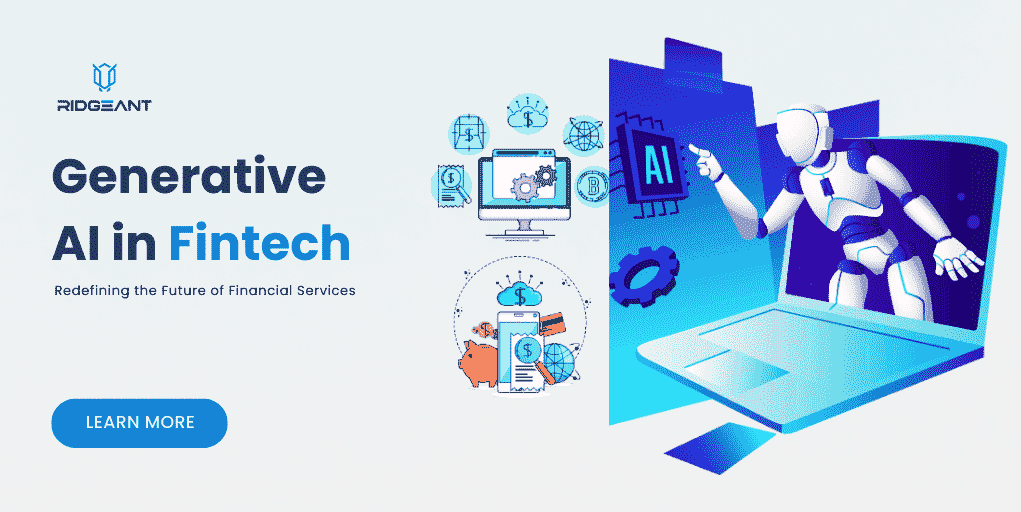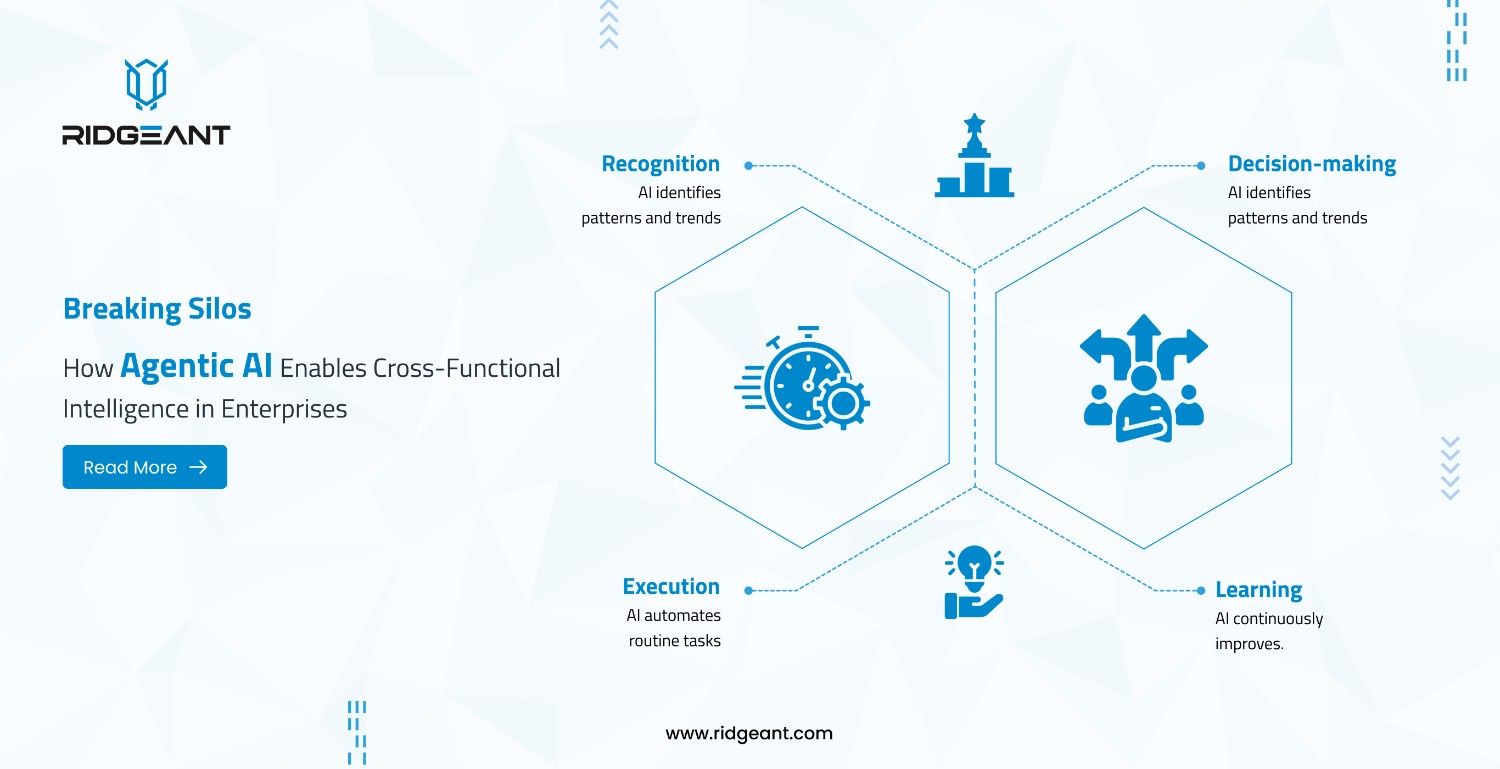
Generative Artificial Intelligence in Fintech
- Machine Learning, ML and AI, Generative AI, Artificial Intelligence
- November 17, 2023
- Ridgeant

We are living in a full-fledged digital era, and in recent years, artificial intelligence (AI) has become a game-changer across various industries, including finance. One of its particular subsets, known as Generative Artificial Intelligence (Generative AI), holds immense potential to revolutionize the way financial services are delivered.
How does it work? By utilizing advanced algorithms and neural networks, this tech has the ability to generate new content and insights, creating a paradigm shift in Fintech.
In this blog, we will further explore the various use cases, workings, benefits, and challenges of Generative AI in Fintech and finance.
Let’s begin with the use cases of this technology in finance. In these, we’ll compare older and modern methods to understand the strength of Generative AI services better.
Use Cases of Generative AI in Fintech
Fraud Detection and Prevention:
As expected, massive amounts of financial data can be analyzed by generative AI, which can also spot patterns and fraud-related anomalies. Therefore, by leveraging this technology, financial institutions can significantly enhance their fraud detection and prevention measures, safeguarding customers’ assets and maintaining the integrity of the financial system.
- Older tools: Rule-based systems and statistical models were traditional methods used for fraud detection and prevention. They mainly relied on predefined rules and patterns to flag suspicious transactions.
- Current tools: Support vector machines, random forests, and neural networks are instances of machine learning algorithms used in fraud detection nowadays. These algorithms are trained on large datasets to learn patterns and identify anomalies in real time.
Based on overall time efficiency and reliability, it is clear which option is the better choice.
Portfolio Optimization:
This wonderful technology can simulate and generate optimized investment portfolios by analyzing historical market data, risk profiles, and investment objectives. This enables financial advisors and investors to make data-driven investment decisions, maximizing returns and minimizing risks. Meaning it potentially reduces the big tasks handled by even bigger manpower.
- Older tools: Modern portfolio theory (MPT) and mean-variance optimization have been popular tools for portfolio optimization. These methods rely on historical return and risk data to construct optimal portfolios.
- Current tools: Portfolio optimization makes use of sophisticated optimization algorithms, i.e., particle swarm optimization and genetic algorithms. These algorithms consider multiple factors, including risk objectives, return targets, and investment constraints, to generate optimal portfolios.
Chatbots and Customer Assistance:
As you may have observed on various sites, chatbots make it easier to navigate through extensive websites and their pages. This is because generative AI-powered chatbots provide personalized financial advice and assistance to customers. These chatbots can also understand customers’ needs, recommend suitable financial products, and answer queries in real-time. Such automated customer service enhances customer experience and reduces the burden on human customer support teams, benefitting both the business and customers.
- Older tools: Basic rule-based chatbots were commonly used in the past to handle simple customer queries. These chatbots followed predefined rules to provide limited assistance.
- Current tools: Natural Language Processing (NLP)-powered chatbots are extensively used in finance. These utilize machine learning algorithms and NLP techniques to understand natural language queries and provide context-aware responses. They also handle complex conversations, support multiple languages, and continuously learn from customer interactions.
Risk Assessment:
Financial institutions are always vigilant about reducing risk since it affects people’s lives and their reputations significantly. Generative AI comes to the rescue here as well as it can analyze market trends, historical data, and macroeconomic indicators to assess the financial risks associated with various investment opportunities. By providing accurate risk assessments, financial institutions can optimize their risk management strategies, improving their overall performance and stability.
- Older tools: Traditional risk assessment methods relied on historical data and statistical models like Value at Risk (VaR) to estimate potential losses in investment portfolios.
- Current tools: Advanced risk assessment tools leverage Generative AI and machine learning algorithms to assess risks. Hence, they provide more accurate and dynamic risk assessments for improved decision-making.
How Generative AI Works in Fintech
After learning about the use cases, you must be curious about how do these machines can generate new and exciting content. And as we’re on the topic, Generative AI is the answer! This is a branch of machine learning where new content is created using algorithms to mimic what was seen in the training set.
In Fintech, it is mostly used to analyze and generate complex data sets and provide insights for various financial operations. To understand it better, let’s break it down into its most basic components. It consists of the discriminator and the generator, two crucial parts.
The generator is responsible for crafting fresh ideas such as investment strategies, financial reports, or trading signals, while the discriminator evaluates the quality of the generated content. As the generator continues to iterate, it gets better and better at producing authentic and relevant content.
Furthermore, the generator receives input data, which may include historical market data, customer profiles, and economic indicators. It then processes this data through multiple layers of connected nodes, similar to how the human brain functions. The output from the generator is the generated content, which can include investment recommendations, risk assessments, or market predictions.
It’s quite amazing to learn about what machines can do these days, isn’t it?
Generative AI Applications in Fintech
After getting to know how Generative AI actually works, let’s look at a few application examples to understand the use of generative AI in finance more.
- Feedzai: This tool uses cutting-edge machine learning algorithms, human intelligence, and big data analysis to analyze millions of transactions per second using state-of-the-art Generative AI. It does this by detecting and blocking fraudulent activity in real time. It really is revolutionary in the fight against fraud!
- BlackRock Aladdin: This platform leverages Generative AI to create optimized investment portfolios by analyzing historical market data, risk profiles, and investment objectives. It is one among several portfolio optimization tools that use Generative AI to empower financial advisors and investors to make accurate investment decisions.
- Clinc: It’s a conversational AI platform that uses AI to create sophisticated chatbots that can comprehend intricate sentences and correctly answer users’ questions. It is also skilled at making financial recommendations based on the risk tolerance and financial objectives of users.
- Ayasdi: By leveraging the Generative AI power, its anti-money laundering platform constructs a virtual “risk cube” that keeps track of the financial, reputational, and regulatory risks associated with each banking transaction. This allows banks to quickly identify and mitigate any potential risks, keeping their operations safe and secure.
Challenges of Generative AI in Fintech
Have you ever wondered about the downsides of Generative AI? While it definitely has its benefits in the world of finance, there are a few things you should be aware of as a financial firm. Think of it like a coin with two sides – one sweet, one sour. Let’s take a closer look at some of the sour parts.
- Interpretability:
Have you ever come across content that just doesn’t make sense? It’s like you’re trying to decipher a code that only a computer can understand. That’s because it probably was generated by Generative AI. Even though AI is highly effective, there are instances in which it is not interpretable, making it troublesome to figure out how an algorithm arrived at a specific outcome. It’s crucial to ensure transparency and interpretability in Generative AI outputs. Doing so not only helps us gain trust but also allows us to make informed decisions.
- Ethical Considerations:
The field of Generative AI is rapidly evolving, and while it presents many exciting opportunities, it also raises some ethical concerns. With financial decisions being increasingly driven by AI, it’s only fair to ensure fairness, transparency, and accountability. As an established firm, you must see some regulations and guidelines in place to address these concerns and safeguard consumer interests to foster a safe and equitable AI-driven financial landscape for all.
Recollecting the Benefits of Generative AI in Fintech
You can start utilizing AI’s benefits in Fintech once better interpretations and regulations are in place. Let us revisit them once more.
- Enhanced Decision-making:
As we all know, the world of finance has become more complex, and financial institutions need accurate insights and predictions to stay ahead of the game. Generative AI is the key to unlocking a wealth of data, enabling institutions to make informed and data-driven decisions. By leveraging its strengths, your business can develop smarter investment strategies, manage risks more effectively, and ultimately boost its profitability. To put it simply, with generative AI at your fingertips, you can confidently navigate the ever-changing landscape of the financial industry.
- Improved Customer Experience:
How great is this? By tapping into the power of Generative AI-powered chatbots, financial firms can now deliver personalized and real-time assistance to their customers, driving up satisfaction rates, reducing response times, and enhancing the overall customer experience.
- Enhanced Fraud Detection:
By leveraging generative AI’s analytical prowess, you can swiftly detect and prevent fraudulent activities. Moreover, you’re not only protecting customers from malicious actors but also helping reduce financial losses and maintain the integrity of the financial system.
Lastly,
Some tidbits to think about when redefining the financial industry’s future
Have you heard about the latest report from the International Monetary Fund (IMF)? They have published a fascinating report on the risks and benefits of Generative AI in finance. According to the report, while this cutting-edge technology can bring about some significant advantages, it also poses several new risks that need to be carefully managed. The IMF recommends that financial institutions should take proactive measures to mitigate these risks by developing proper governance frameworks, closely monitoring algorithms, and partnering only with top-notch technology providers.
Similarly, according to a recent paper published by the IMF’s Finance & Development magazine, Generative AI can generate valuable insights and recommendations for the financial industry. However, it’s essential to ensure that these generated insights align with regulatory requirements and industry standards. The paper highlights the importance of flexibility, ethical considerations, and regulatory compliance when implementing Generative AI in financial services.
Conclusion
In summary, the potential of Generative AI in the Fintech industry is significant, and it can help optimize operations, enhance customer experiences, and provide a competitive edge for businesses. It does automate financial operations and reduces operational overheads in various Fintech processes. And it can also bring revolutionary changes in key areas such as asset management, securities trading, customer engagement, and credit decisions. By doing so, businesses can make quick and accurate decisions.
To reiterate, Generative Artificial Intelligence has the potential to reshape the way financial services are enhanced and delivered. From fraud detection to portfolio optimization and customer assistance, it is paving the way for the future of finance. However, financial institutions must address the challenges and ethical considerations associated with this technology to harness its power fully. With the right approach, Generative AI can lead to more accurate decision-making, enhanced customer experiences, and a more secure and efficient financial system.














